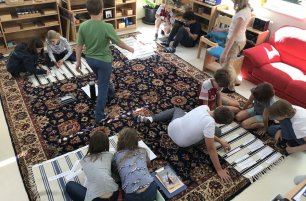Montessori Sensorial Materials Lead to Sensory Awareness
The materials in the Sensorial area of the Montessori classroom are quite unique – they speak to the tactile observer in all of us. When you consider the way humans take in information, you realize how often we use more than one sense to explore. Maria Montessori’s work in the Sensorial environment was designed to take advantage of this tendency. Today, I will discuss the materials featured in the Children’s House classroom (ages 3-6).
We commonly think of the five senses as hearing, touching, seeing, smelling and tasting. However, Maria Montessori considered and designed materials to stimulate also the baric sense (sensing weight), chromic sense (sensing color), thermic sense (sensing temperature) and stereognostic sense (ability to identify shapes and objects based on touch alone).

The beauty of the sensorial materials in the Primary environment is that they are not meant purely for the exploration of the sense; rather they are intended for the refinement of the senses. It is this refinement that leads to new discoveries. For example, a child has likely experienced the concept of “light” and “heavy” in their real-world experiences; however, they need additional understanding to discern between “light” and “very light”. This understanding is brought about by exploring and experiencing the graded materials in the Sensorial area. The controlled exploration of these materials allows them to distinguish weight, texture, shades of color, and more.
The Sensorial materials all isolate a particular quality (such as length, weight, etc.) which allows the child to focus on that one quality. In addition, the materials all have a control of error, enabling the child to notice when something doesn’t seem right and make the corrections themselves.

When visiting a Montessori classroom, here are some of the Sensorial materials you will see:
The Pink Tower (incidentally one of my favorites) features 10 pink cubes with a side measuring 1 to 10 centimeters, at regular intervals. Children often build a tower of the cubes, which reinforces the concept of large, small and its gradation.
The Brown Stair has 10 prisms, each 20 cm in length and varying in thickness from 1 to 10 cm. They help children understand the concept of thick and thin through exploration of the prisms, especially placing increasingly thinner prisms in succession to create a downward staircase.
The Red Rods include 10 rods which are equal in diameter but vary in length, providing a tangible way for children to experience long and short.
The Cylinder Blocks are wooden blocks that contain 10 cylinders of various sizes. There are 4 sets of blocks in total, designed to help children to distinguish between large and small, tall and short, and thick and thin.
The Binomial Cube contains colored cubes and prisms, all which are stored in a box with the color pattern on it. The child is able to sensorially explore the mathematical equation (a+b)3. The Trinomial Cube is similar to the binomial cube, but has slightly different colored cubes and prisms. It represents the mathematical equation (a+b+c)3.
The Constructive Triangles are a set of wooden triangles that can be combined to form various shapes such as a parallelogram, hexagon, rhombus, and trapezoid providing children a tactile and visual experience with geometric shapes.
These are just a few of the materials in the robust Sensorial area of a Montessori classroom. I hope you get the chance to explore them yourself!
Want to learn more? Read our next article:








